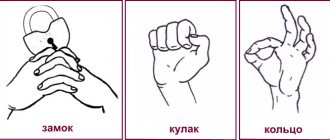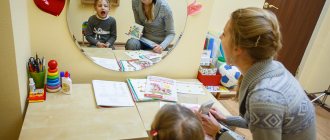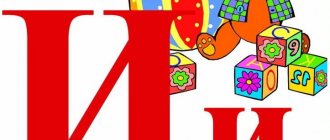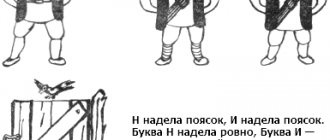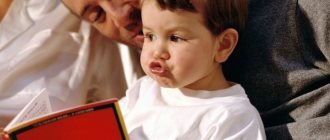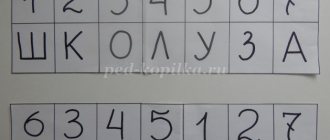Summary of individual speech therapy lesson Automation of sound [s']
Topic: Automation of the sound [s'] in syllables, words, phrases.
Goal: to consolidate the clear pronunciation of the sound [s'] in syllables, words, phrases.
Objectives: Educational: Consolidation of syllabic analysis skills
Correctional and developmental: development of phonemic processes
Educational: developing control over one’s own speech
Equipment: 2 toys (piglets), toy house, wardrobe, costume, paper flowers and leaves, counting sticks, picture maze.
Progress of the lesson
I. Org. moment
Guess the riddle and find out who will come to our class today. Crochet tail, heel nose. Who is this? (Piglet). Right. This is what we have. (The speech therapist shows the toy). And his name is Sema. He is going to go visit his friend Masyana.
II. Articulation gymnastics
In order to go on a visit, you need to wash, get dressed, dress up. Sema goes to brush her teeth. How does Sema brush his teeth and tongue? (Example: brush your lower teeth, clean your tongue). Sema brushed his teeth and smiled. How did Sema smile? (Exercise smile).
III. Face massage
And now Syoma is washing his face. And we wash our face, rub our cheeks together. Wash your nose, ears, forehead, wash your face and move on.
VI. Mimic gymnastics
Sema thinks about what to wear. He remembered that he had a suit and was happy. (Show how happy Sema was). I opened the wardrobe and didn’t find the suit. I was surprised. Then I got upset. (How surprised, upset?). I found a suit. I was happy. (How happy were you?).
V. Articulation analysis
What sound do I highlight in the names SEMA, MASYANYA. Say it. What shape do your lips take when you pronounce the sound [s']? Where is your tongue when you pronounce this sound?
VI. Sound Characteristics
Tell me what you know about the sound [s']? Is the sound [s'] a vowel or a consonant? Hard or soft? Voiced or voiceless?
VII. Breathing exercises
The wind blew and autumn leaves flew into the room. They urgently need to be removed. Sema can’t cope quickly on his own, help him. (Blowing paper leaves off the surface of the table. Control over the air stream that should come from the tongue is required.)
VIII. Development of phonemic hearing in syllables
Pig Sema came up with a game for his friend and wants to consult with you: do you think Masyanya will like such a game? I name the syllables, and as soon as you hear the sound [s'], you clap your hands. - SYA-; -SE-; - RY-; - YAS-; — AXLE-; -BA-; -AR-; -ASH-; ETC.
IX. Consolidating sounds in syllables, developing a sense of rhythm
Well, it's time to hit the road. But the trouble is, the door slammed shut. Piglet Sema cannot get out of the house. To open the door, you need to cast a spell. I'll try to help you. Repeat after me. SYA - SYA; SYA – SYA – SYA; ya – ya; ya - ya - ya; SIO – SIO; SIO - SIO - SIO; Yos - Yos; Yos - Yos - Yos; SY – SY; SY – SY – SY; Yus - Yus; Yus - Yus - Yus; The last spell turned out to be correct and the door opened.
X. Fixing sounds in words
"Picture Labyrinth" Look how confusing the path is. Now you and Sema will walk along this path, and so as not to get bored, sing the song s' - s' - s'. On this path you will meet baby animals and birds, be prepared! (The child runs his finger through the maze, naming the cubs that he meets along the way: elk calf, lynx calf, piglet, fox cub, gosling.) XI. Finger gymnastics Let's count who you met? (The child names the cubs and bends his fingers.) You greeted everyone you met. Who did you say hello to? (He lists who he greeted (he said hello to the little fox, to the gosling, to the calf of elk, etc.), while connecting the thumb to the other fingers one by one.)
XII. Development of phonemic hearing in words
You have come to a boring clearing, there is not a single flower on it. Let's try to decorate it? I will name the words, and you will repeat after me. As soon as you hear the sound [s'], you will put a flower in the clearing. (SIEVE, DESK, SEVEN, CANCER, VILLAGE, PIG, NOTEBOOK, LETTER, NET, PEN, CHITCH).
XIII. Syllable analysis
There is a river in front of you. There is no way to cross it. We need to make a bridge. To do this, break down the words into syllables. How many syllables are in a word, so many shelves you put. (JELLOW, Ribbon, GOOSE, TEN, NORTH, SIEVE, ELK. LYNX, ORANGE). XVI. Agreement of nouns with adjectives So you have reached Masyanya, and he meets you. Tell me, Masyan, who did you meet? What are they? (We met a calf, a gosling, etc. A gosling - small, yellow, etc. a calf - ...., a piglet ...
XV. Bottom line
Author of the material: Gondar Elena Alekseevna
Also on topic:
Automation of sound [С] in sentences
Summary of individual speech therapy sessions. Automation of sound L
Individual speech therapy lesson: “Automation of sound [l].
Russian folk tale “Turnip” Purpose: the lesson is designed for speech therapists. (Child with visual impairment (amblyopia)
,
OHP level 4. GOAL: automate the sound /L/ in syllables, words and sentences. Tasks: pronouncing the sound [l]. - Practice correctly pronouncing the sound [l] in syllables and words - Strengthen the skill of isolating the sound [l] from a number of words. - Continue learning to form prefixed verbs. - Exercise in the formation of antonyms - Activate vocabulary, develop logical thinking. - develop speech breathing; - develop the articulatory apparatus; - develop phonemic perception; - develop grammatical structure and coherent speech; - form and develop auditory and visual attention, fine motor skills and memory.
Equipment:
characters of the table theater "Turnip", a plate with peas, an empty plate, a mirror.
Progress of the lesson:
there is a house, the figures are hidden behind the house.
1. Organizational moment.
- Guess which fairy tale characters we will meet today in class:
To collect the harvest, Grandfather had to call: Grandma, granddaughter, Bug, cat And even a tiny mouse.
So the big yellow... (turnip) sat firmly in the ground. 2. Articulation gymnastics.
Grandfather woke up
(Child puts up a figurine of grandfather)
, opened the window
(exercise “Window”)
and began to do exercises
(exercise “Swing”)
Drank a cup of tea
(exercise “Cup”)
with jam
(exercise “Tasty Jam”)
. Grandfather went out to the garden
(exercise “Fence”)
and decided to plant a turnip, began to dig a hole
(exercise “Shovel”)
. The turnip began to grow
(exercise “Sail”).
A child performs exercises in front of a mirror.
2. He watered it in the morning and evening: - l-l-l. (Draws the child’s attention to the position of the tongue while pronouncing the sound [l].)
I weeded the grass around the turnip:
-la-la-la, lo-lo-lo, ly-ly-ly, le-le-le, Lu-lu-lu.
He loosened the earth:
al-ol-ul, ol-ul-ul, ul-ul-el, al-el-al.
And when the turnip grew, he began to pull it:
pla-pla-pla-ple, clo-clou-clou, sle-sla-slu.
But he can’t pull it out.
The child repeats syllable chains after the speech therapist.
4.
Grandfather called...grandmother
.
The grandmother runs, scatters peas from her pocket, and loses the sound [l] from the words. Pick up a pea and say the word correctly: ..ampa pi..a hundred.. ..ozhka we..o foam.. The child transfers the peas from the table to a plate and says the words.
They pull the turnip, but cannot pull it out.
The child places the grandmother figurine behind the grandfather.
5.
They called... their granddaughter.
And the granddaughter sits in front of the mirror, preens herself and asks the mirror: “Am I cute?”
And the mirror answers her: “Sweetheart.” - “Am I nice? I am cheerful? Am I obedient? I am brave? Am I affectionate? What did the mirror answer to your granddaughter? The child answers with an affirmative intonation.
The granddaughter ran to the garden, but on the way mosquitoes flew at her.
She flaps her hands, catches mosquitoes, and when she hears the sound [l] in the word mosquito, she joyfully shouts: “I caught it!” Help your granddaughter, listen carefully to the words: boat-spoon-cat, stick-can-beam, booth-roll-burka, table-chair-knock. The child places a figurine of his granddaughter.
The granddaughter came running into the garden. They pull the turnip, but cannot pull it out.
6.They were tired and decided to rest.
Finger gymnastics.
finger exercise “Grandfather” -
show an imaginary beard with your hands from top to bottom.
finger exercise “Granny” -
show how the corners of a scarf are tied under the chin.
finger exercise “Turnip” -
with both hands, from top to bottom, draw a circle in the air with a pointed tip at the bottom - in the shape of a turnip.
finger exercise “Bow”. -
fold the fingers of both hands with a pinch and connect the fingertips in the form of a figure eight.
finger exercise “Dog”.
- extend the middle, ring and thumb fingers, connect the pads - this is the “face” of the dog.
Raise your index finger and little finger up - these are the “ears”. finger exercise “Cat” -
connect the middle and ring fingers with the big one so that you get a ring - this is the “face” of a cat.
Raise your index finger and little finger - this is how the cat's ears stick out. finger exercise “Mouse” -
connect the tips of the middle and ring fingers to the thumb.
Bend the index and little fingers and press the tips to the middle and ring fingers. 7.
They called... Bug
.
And at this time the Bug and the Cat are arguing: the Bug says a word, and the Cat argues with her, help the Cat. Game “Say the opposite”
Work is laziness.
Easy - difficult. Friends are enemies. Easy - hard. Hardworking is lazy. Old - young. Full - hungry. Light heavy. Zhuchka and the cat came running, but they couldn’t pull out the turnip. The child places the Bug and Cat figures behind the grandmother.
8. Then they called...the mouse.
Game “Say the Word.”
The mouse heard its name called.
The speech therapist shows a mouse on a figurine. out of the house...ran out, along the path...ran. She ran across the river across the bridge, to the garden... she ran, through the gate... she ran, she came close to her grandfather... she ran up. The child places the mouse figurine behind the cat.
We pulled everything together and pulled out the turnip!
The speech therapist pulls out a model of a turnip.
9. Summary of the lesson.
So the fairy tale ends.
Why do you think the turnip was pulled out? The child explains (because they all pulled together, helped each other)
We recommend watching:
Summary of an individual lesson in a secondary speech therapy group on the topic “Automation of sound C” Synopsis of a combined speech therapy lesson in a preparatory group A simulator for individual and group work with students on the differentiation of consonants that have acoustics Synopsis of an individual speech therapy lesson for children 3-4 years old
Similar articles:
Lesson notes for a senior speech therapy group. Sound K
Summary of GCD for children of the senior speech therapy group
Summary of a speech therapy session with children 5-6 years old with mental retardation
Summary of educational activities in the older group of children with severe speech impairments on the topic: “Sounds S - Z”
Summary of educational activities in the senior group of children with severe speech impairments on the topic: “Sounds S - Sh”
